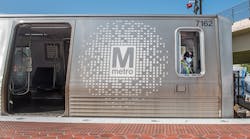WMATA increasing train service across rail system
The Washington Metropolitan Area Transit Authority (WMATA) is increasing train service across the rail system. Weekday service will see an infusion of trains, as well as weekends.
The improvements correspond to growing ridership, with new post-pandemic records being set almost daily. During the week of March 13, Metrorail saw its highest ridership since the pandemic, with more than 337,000 paid trips on March 15, followed by the second highest day on March 16 with more than 335,000 trips. Cherry blossom season, tourism, sporting events, entertainment and increased commuters are driving the trend.
“As we add trains and improve service, more and more people are choosing Metrorail,” said WMATA General Manager and Chief Executive Officer Randy Clarke. “Our teams are working hard every day to get more 7000-series trains in service and hire more people, so we can make #YourMetro even better.”
Service will ramp up across the system through March 25, providing customers with more frequent, reliable service that makes transfers easier and wait times shorter. Starting first, as of March 20, customers on the Silver, Blue, Orange, and Blue+ lines will see trains every 12 minutes through March 24 during rush hours (6 a.m. to 9 a.m. and 3 p.m. to 6 p.m.). Between Rosslyn and Stadium-Armory, the central part of the rail system where multiple lines overlap, trains will arrive in stations on average every three minutes during rush hours.
On March 25, service will improve on the Red Line, increasing service to every eight minutes through 9:30 p.m., seven days a week, instead of just rush hours and midweek. The change aligns with service on the Green Line, which already operates every eight minutes on weekdays and weekends.
Additional service improvements are expected over the coming months as WMATA hires more train operators, mechanics and maintenance workers and increases the availability of 7000-series railcars.



